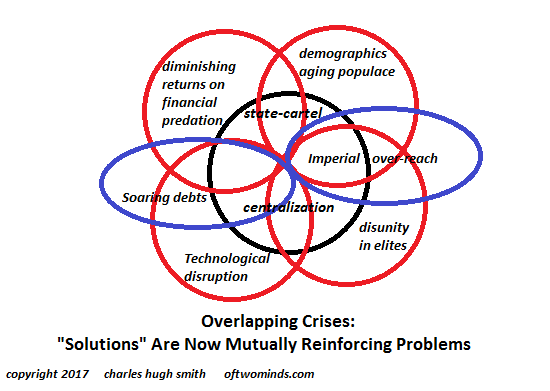The Overlapping Crises Are Coming, Regardless of Who’s in Power
Commentators seem split into three camps: those who see Trump as a manifestation of smouldering social/economic ills, those who see Trump and his supporters as the cause of those ills, and those who see Trump as both manifestation and cause of those ills.
I think this misses the point, which is the overlapping crises unfolding in this decade– diminishing returns on skyrocketing debts, the demographics of an aging populace, the erosion of the social contract and the profound disunity of political elites–will continue expanding and feeding on each other regardless of who is in power.
Historical analysis seems to swing between the “Big Man/Woman” narrative that views individuals as the drivers of history, and the “Big Forces/it’s all economics” narrative that sees individual leaders as secondary to the broad sweep of forces beyond the control of any individual or group.
So while the mainstream views President Lincoln as the linchpin of the Civil War–his election triggered the southern secession–from the “Big Forces/it’s all economics” view, Lincoln was no more than the match that lit a conflict that was made inevitable by forces larger than the 1860 election.
The tension between these two narratives is valuable, as history cannot be entirely reduced to individual decisions or broad forces (weather, resource depletion, financial crisis, geopolitical upheaval, demographics, plague, etc.). The dynamic interplay between the two shapes history.
Individuals do matter–but they cannot offset structural crises for long.
Which brings us to Trump. The status quo is falling apart for profoundly structural reasons: promises made when growth was robust, debt was modest, energy was cheap and abundant and the work force was far more numerous than those dependent on the central state’s “pay as you go” pension and welfare programs– these promises made in yesteryear can no longer be kept, regardless of who’s in power.
We cannot get blood out of a turnip, and those who claim we can are only exacerbating the coming crises with their fantasies and denials.
I’ve been addressing these slow-moving, inevitable crises for the past 10 years. Despite the illusion of tepid “growth” and the maintenance of the status quo, beneath the surface everything is becoming much more fragile and increasingly brittle.
Even Timothy Geithner concedes this in his recent Foreign Affairs article on how to deal with the next global financial crisis. The central banks and states have expended all their ammunition– lowering interest rates, creating money out of thin air to bolster systemic liquidity, buying bonds and other assets to prop up shaky markets, and borrowing immense sums to prop up government spending– and there is little left for the next crisis.
Why I Have to Agree with Tim Geithner on This (March 8, 2017)
And this sober view–that some additional central bank trickery can save the system in the next financial crisis–assumes things that are unlikely to be true: what if energy is no longer cheap and abundant? What if global weather isn’t conducive to grain surpluses? What if central banks buying stocks no longer props up the market? What if debt finally reaches levels that cannot be sustained?
Could Hillary, or some other leader, forestall these deeply structural crises? The short answer is no. The only thing a leader can actually do is lower expectations so the erosion of promises that cannot be kept will be accepted as inevitable, and bolster hope while demanding sacrifices of all those who have benefited from the status quo.
If we look back on great leaders who dealt with one crisis after another, we find they didn’t actually make the crises disappear; they only managed them on the margins, and spoke to the need to make sacrifices for a better future.
If we set aside the rose-colored glasses, we find that Franklin Roosevelt didn’t actually “lead the nation out of Depression.” The nation was still deeply entrenched in the Depression in 1940, after 8 years of FDR’s leadership. It took World War II and federal borrowing and spending on an unimaginable scale to extricate the U.S. from the grip of bad debt the powers that be refused to write off and the resulting stagnation.
Which brings us again to Trump. Since no one can actually resolve these overlapping crises, a focus on the individual leader’s actions is a distraction. Yes, an individual can manage the margins of crisis more or less effectively.
But overlapping mutually reinforcing crises are not a war, with a victorious and a vanquished side. As Peter Turchin and other writers I have quoted and discussed for many years have detailed, these structural trends play out regardless of policy tweaks or grand pronouncements. Leaders who manage to ease the decline or temporarily reverse it are considered successes; those who exacerbate the decline are considered failures.
Why Our Status Quo Failed and Is Beyond Reform.
No leader can reverse the dynamics of mutually reinforcing crises. No one can reverse the diminishing returns on financialization, debt, centralization, financial fakery, rentier state-cartel parasitism, or reverse the decline in paid work, the erosion of well-being and health and rising inequality.
There is no way to actually forestall the reckoning as the forces of demographics, financial predation, Imperial over-reach, soaring debts, political disunity, technology disruption and the failings of state-cartel centralization grind up the status quo.

This essay was drawn from Musings Report 5. The weekly Musings Reports are emailed exclusively to major donors and patrons ($5/month or $50 annually).
Recent podcasts/video programs:
Keiser Report: Jon Corzine’s Big, Bad Bond Bet (25:43 min., 2nd half)
Self-Employment & Financial Bubbles (1:26 hrs)
Charles Hugh Smith On Inequalities And The Distortions Caused By Central Bank Policies (30 min.)
Rogue Money (56:59 min.)
If you found value in this content, please join me in seeking solutions by becoming a $1/month patron of my work via patreon.com.
Leave a Reply